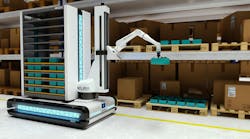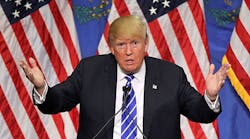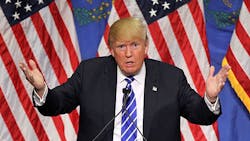(This is a contributed piece from Bloomberg News and does not necessarily reflect the opinion of New Equipment Digest)
Just about everything Donald Trump says about trade is wrong, but his use of trade-deficit numbers is especially so.
To understand why, consider his attacks on Apple, which he accuses of destroying American jobs by making devices in China.
LAS VEGAS, NV - OCTOBER 08: Republican presidential candidate Donald Trump speaks during a campaign rally at the Treasure Island Hotel & Casino on October 8, 2015 in Las Vegas, Nevada. During the rally, Trump said people were giving him credit for helping force Kevin McCarthy to bow out of the race for Speaker of the House. (Photo by Isaac Brekken/Getty Images)
QuickTake Free Trade Feud
The company just unveiled a sleeker, upgraded iPhone that it plans to sell for less than $400. The device was designed and engineered in the U.S. Its software was developed by Apple in the U.S. Many of the phone's parts come from suppliers outside China, including the U.S., Germany, Japan and South Korea.
But because China assembles and ships iPhones -- adding only about $6.50 in value, according to one study -- government statisticians worldwide register the entire wholesale value of the device as an export from China. The full value of phones destined for the American market count as imports to the U.S. (The figures subtract the value of any U.S.-made components shipped to Foxconn, Apple's assembler, in China).
You can see how the U.S. trade deficit can quickly become inflated. One economist who tried in 2011 to calculate how much concluded that the U.S. trade deficit with China would shrink by 40% if trade data reflected value added, not final assembly. Most developed countries' trade deficits with China would also be much smaller.
Apple maintains a vast global supply chain that includes about 200 companies for all its products. This network allows Apple to exploit lower-cost labor, but also to take advantage of the expertise of Taiwanese suppliers of touch-ID sensors, for example, and Japanese camera suppliers.
Apple tries to make this point when it stamps on the back of each of its devices: "Designed by Apple in California. Assembled in China."
The same trade-deficit inflation occurs for thousands of other products, from Nike shoes to Disney toys to Ford Fiesta subcompact cars, sold in the U.S. but assembled in China, Mexico or elsewhere. More than 80% of world trade in manufactured goods consists of raw materials and components that come from multiple countries, so by extrapolation more than 80% of manufacturing trade data are illusory.
So when Trump repeatedly claims that the U.S. trade deficit with China is $505 billion a year, don't believe it. Not only does he get his facts wrong -- the actual deficit with China last year was $365 billion -- he also fails to account for the exaggerated contribution of final-assembly countries.
Adjusting for such over-counting, the real U.S. trade deficit with China is 40% lower at about $219 billion. (Trade experts would say that's too simple a calculation because it fails to disentangle where components are made, but you get the picture.)
There's another reason Trump is wide of the mark. The U.S. trade deficit isn't necessarily bad and, in fact, can be seen as a positive. A trade deficit isn't an actual loss of money, as Trump says, but a dollar figure attached to how much more we buy from China than China buys from us.
Not only do consumers get something in return -- a car, a computer or an iPhone -- trade deficits show that the U.S. is a wealthy country with higher levels of income, investment and consumer confidence than emerging economies like China, and thus able to afford lots of imported stuff.
Deficit-disapprovers are right to say that a trade deficit amounts to borrowing from abroad. In effect, Americans are selling long-term assets to finance current consumption. But the deficits-are-benign school makes a valid case by saying that, when the U.S. imports more than it exports, it is essentially importing capital to finance domestic production and increase domestic employment.
Nor is it true that when imports exceed exports, jobs are necessarily lost to cheaper labor overseas. Seven years after the U.S. signed the 1994 North American Free Trade Agreement, the trade deficit hit a record high and unemployment fell to 3.8% -- the lowest point in three decades. (I chose 1994-2000 to avoid distortions from the 2001 terror attacks, the 2002 technology collapse and the 2008 recession.)
When the economy is growing and employment is increasing -- in other words, when all is well -- the U.S. trade deficit generally gets worse. When the economy is contracting, the trade deficit usually shrinks, as it did in the 2008-2009 recession.
Trade can, of course, erode employment in particular industries and depress communities that can't recover, as MIT economist David Autor and others have shown in recent research.
This happened in the U.S. Rust Belt after China's 2001 entry into the World Trade Organization. Workers' wages in local labor markets exposed to Chinese competition declined by $213 a person annually. Another study found that Chinese imports from 1999 to 2011 cost up to 2.4 million U.S. jobs.
In a world where trade deficits aren't what they seem, and the evidence of trade's benefits remains strong, the solution isn't to rip up trade agreements or impose barriers that could trigger a trade war. The solution is to help workers maintain their standard of living through retraining, relocation or retirement if necessary.
In a future column, I'll discuss why U.S. efforts have lagged in these areas and what fresh approaches might spread the benefits of free trade even wider. Not that Donald Trump cares, but his followers should.
This column does not necessarily reflect the opinion of the editorial board or Bloomberg LP and its owners.
Which candidate do you think will be best for American manufacturing and why? We want to hear what you think!











